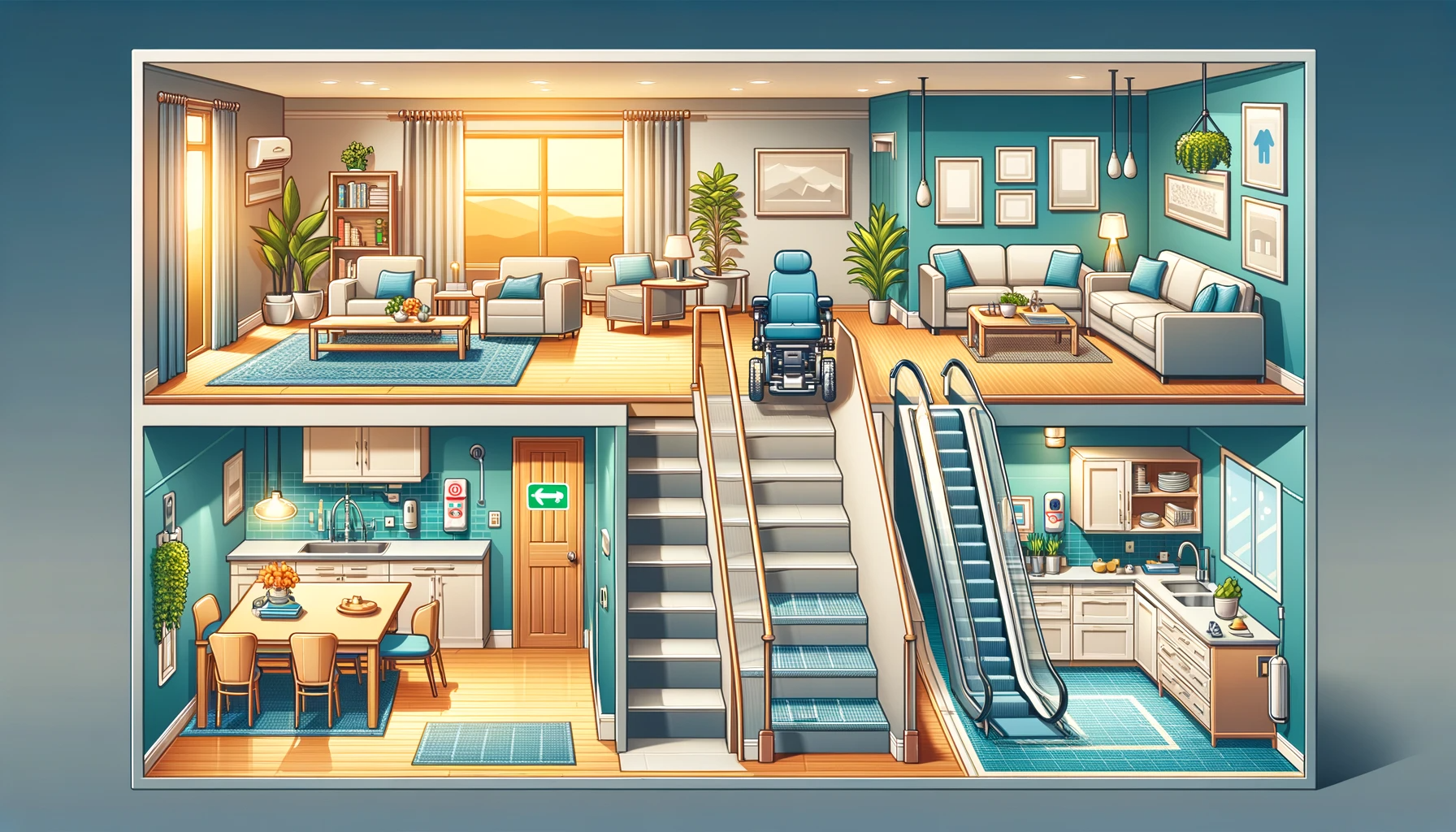Home Safety and Accessibility for Seniors Checklist
Ensuring home safety and enhancing accessibility for seniors is crucial to support their independence and well-being. This comprehensive guide provides valuable insights and practical steps to create a safer and more accessible living environment for older adults.
Understanding the Importance of Home Safety for Seniors
Elderly individuals often face challenges related to mobility, vision, and overall health, making them more susceptible to accidents at home. By understanding these challenges and addressing them through targeted modifications, we can significantly reduce the risks and improve their quality of life.
Common Risks and Challenges in a Senior-Friendly Home
- Mobility Issues: Difficulty in walking or balancing increases the risk of falls.
- Vision Impairment: Poor vision can lead to accidents, especially in poorly lit areas.
- Cognitive Decline: Memory problems can cause confusion and safety issues.
- Health Concerns: Chronic conditions may necessitate specific adjustments at home.
Creating a Safe and Accessible Home Environment
A well-planned approach to home safety and accessibility can make a significant difference. Here are key areas to focus on:
Entrance and Exits for Seniors Checklist
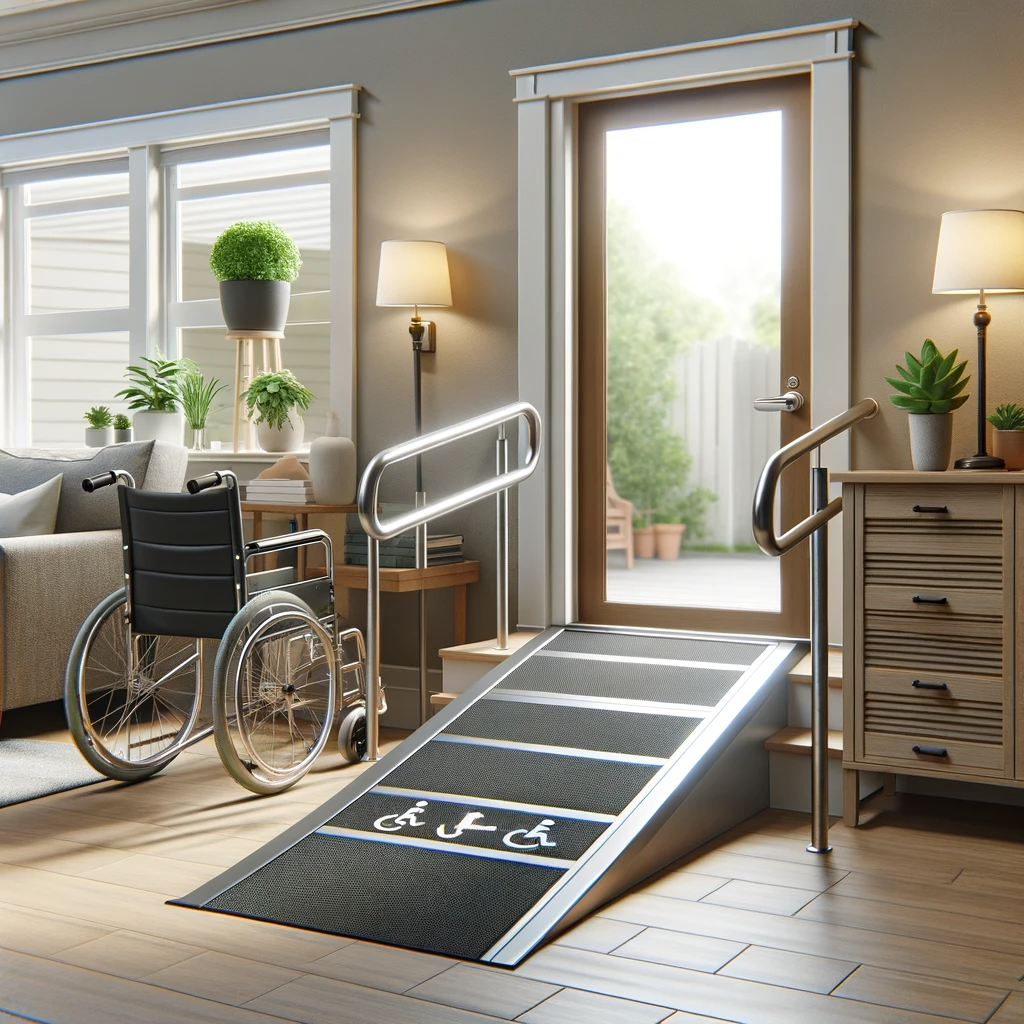
1. Ramp Installation
- Install ramps with gentle slopes for wheelchair or walker access.
- Ensure ramps have non-slip surfaces and are weather-resistant.
2. Handrails for Support
- Add sturdy handrails on both sides of any steps leading to the entrance.
- Handrails should extend beyond the top and bottom of the steps for added safety.
3. Non-slip Mats and Flooring
- Place non-slip mats at all entrances to prevent falls, especially in wet conditions.
- Consider non-slip flooring in entryways inside the home.
4. Adequate Outdoor Lighting
- Install bright, motion-activated lights near entrances and exits.
- Ensure all pathways leading to the door are well-lit.
5. Threshold Modifications
- Lower or remove thresholds to prevent tripping and facilitate wheelchair access.
- Use beveled thresholds for smoother transitions.
6. Door Width and Accessibility
- Widen doorways if necessary to accommodate wheelchairs or walkers.
- Install lever-style door handles for easier operation.
7. Secure and Accessible Locks
- Use locks that are easy to operate, such as keyless entry systems or smart locks.
- Place locks at a reachable height for someone in a wheelchair.
8. Clear and Accessible Pathways
- Keep pathways to entrances clear of obstacles and clutter.
- Ensure paths are wide enough for easy navigation.
9. Weather Protection
- Install awnings or canopies over entrances to protect against rain and sun.
- Ensure proper drainage to avoid slippery surfaces.
10. Visible House Numbers
- Make sure house numbers are large, clear, and well-lit for easy identification by emergency responders.
11. Emergency Access
- Maintain a spare key in a secure location or provide one to a trusted neighbor.
- Consider a lock box for emergency responders if living alone.
12. Maintenance and Repairs
- Regularly inspect and maintain entrances and exits, including steps, ramps, and lighting.
- Promptly repair any damage to ensure ongoing safety.
13. Security Features
- Install peepholes or video doorbells for security without opening the door.
- Consider additional security measures like alarm systems.
14. Slip-Resistant Footwear
- Encourage the use of slip-resistant footwear when entering or exiting the home.
- Provide a bench near the entrance for safely putting on or taking off shoes.
15. Seasonal Adjustments
- In snowy or icy conditions, ensure prompt removal of snow and application of ice melt.
- Adjust lighting and pathway maintenance with seasonal changes for optimal safety.
Living Areas for Seniors Checklist
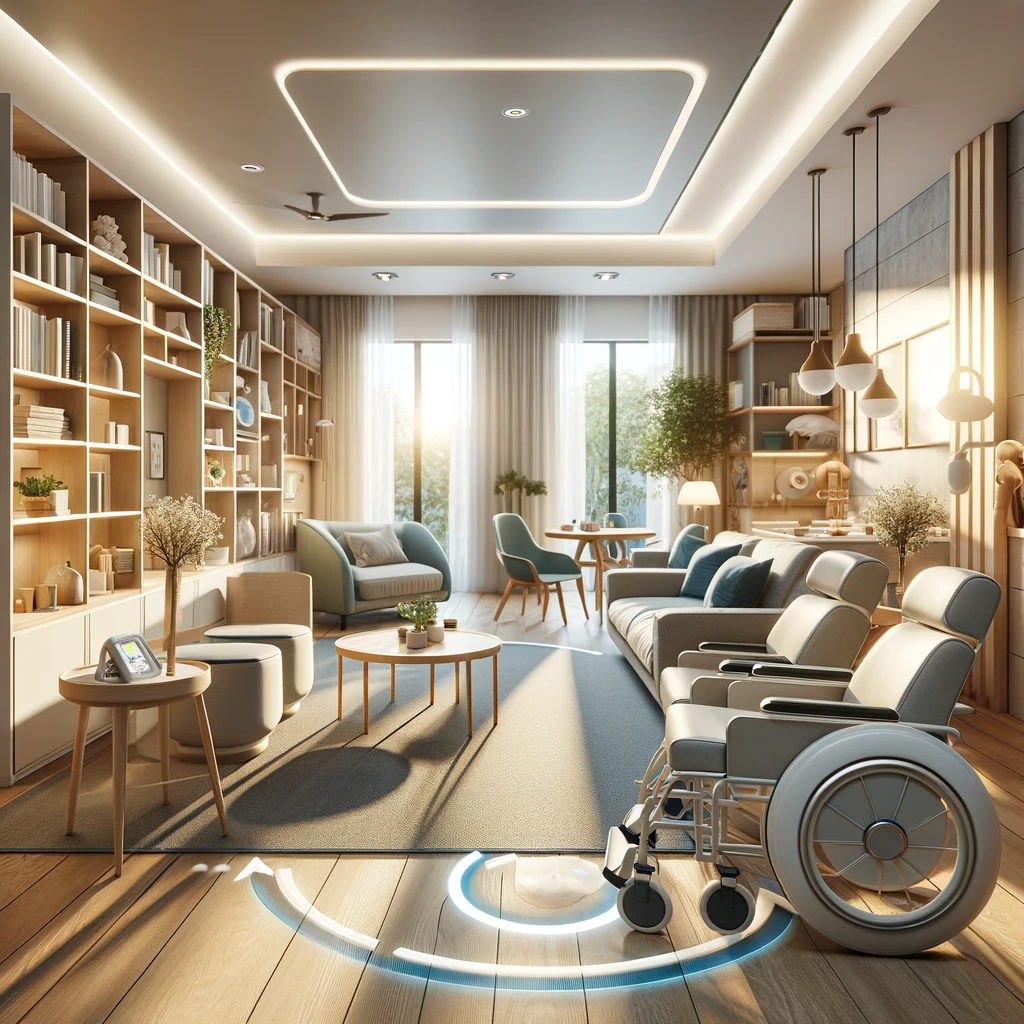
1. Clutter-Free Environment
- Regularly organize and remove clutter to create clear and open walking paths.
- Ensure cables and cords are secured and out of walkways to prevent tripping.
2. Furniture Placement
- Arrange furniture to allow ample space for movement, especially for those using mobility aids.
- Choose stable and sturdy furniture that can support weight if needed for balance.
3. Adequate and Adjustable Lighting
- Install bright, non-glare lighting to improve visibility.
- Use adjustable lamps and lighting controls for personalized comfort.
4. Emergency Response Systems
- Consider installing a home-based emergency response system for quick assistance.
- Keep mobile phones or emergency call buttons within reach.
5. Non-slip Flooring
- Opt for carpets or rugs with non-skid backing to minimize slip hazards.
- Keep floors dry and clean, promptly cleaning up any spills.
6. Easy-to-Reach Storage
- Use shelves and cabinets that are easily accessible without the need for stretching or bending.
- Organize frequently used items within easy reach.
7. Safe Heating and Cooling
- Ensure heating and cooling systems are in good working order.
- Avoid space heaters, or choose models with automatic shut-off features.
8. Fire Safety Measures
- Install smoke detectors and check them regularly.
- Keep a fire extinguisher accessible and ensure seniors know how to use it.
9. Window Safety
- Ensure windows are easy to open and close.
- Install window locks for security and limit opening for fall prevention.
10. Fall-Proofing Measures
- Apply edge guards or corner protectors to sharp furniture edges.
- Consider using walkers or canes for additional support within the home.
11. Decorative Safety
- Use decorations that do not obstruct walkways or create hazards.
- Choose decorative items that are stable and not easily knocked over.
12. Seating Comfort and Accessibility
- Provide chairs with armrests and sufficient back support.
- Ensure chairs and sofas are at a height that makes sitting down and standing up easier.
13. Technology Accessibility
- Use remote controls, voice-activated devices, or smart home technology for convenience.
- Keep chargers and power sources easily accessible.
14. Indoor Air Quality
- Maintain good ventilation and air quality with air purifiers or regular airing of rooms.
- Monitor humidity levels to prevent mold growth and respiratory issues.
15. Personal Emergency Kit
- Keep a small emergency kit with essentials like medications, contact information, and basic first aid.
- Place the kit in a known, easily accessible location.
Kitchen Safety for Seniors Checklist
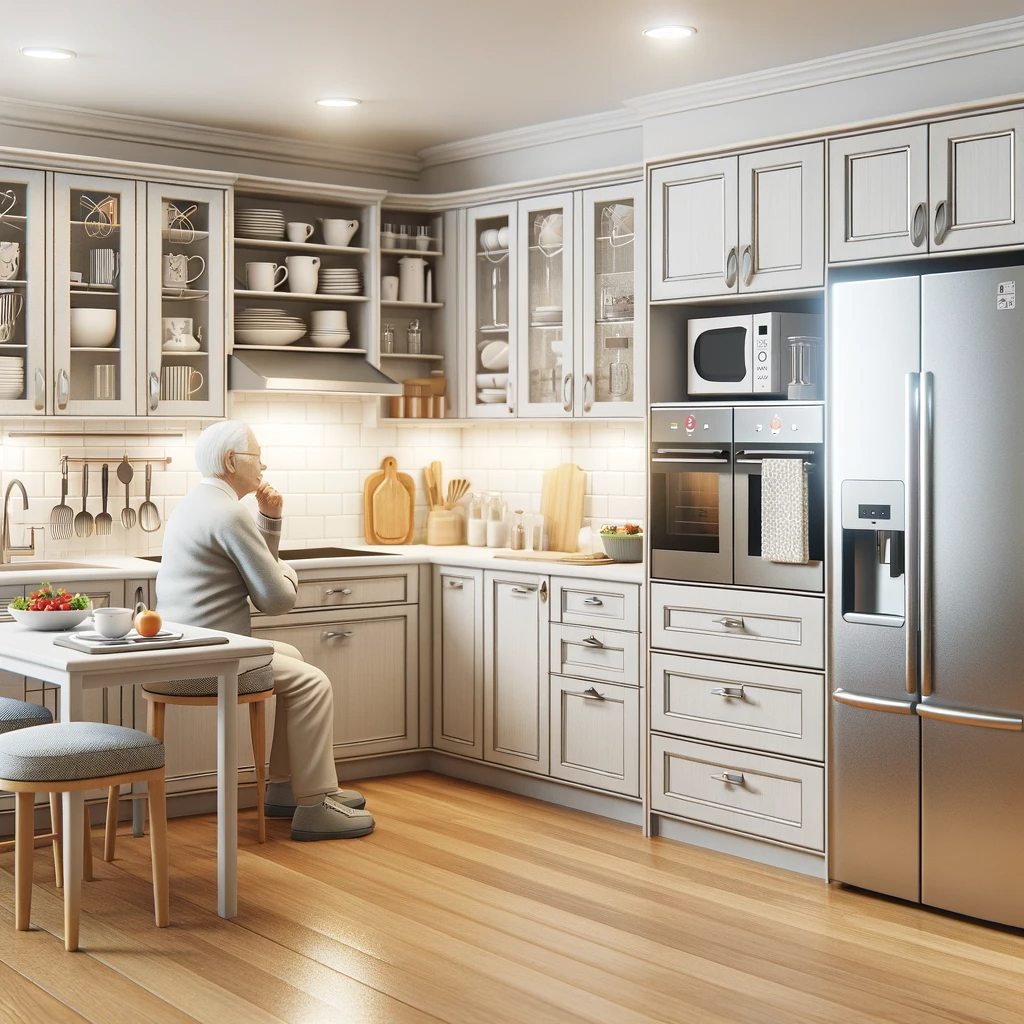
1. Lower Cabinet and Counter Accessibility
- Adjust the height of counters and cabinets for wheelchair or seated access.
- Use pull-out shelves and lazy Susans for easier reach of items.
2. Safe and Simple Appliances
- Choose appliances with simple, clear controls and automatic shut-off features.
- Opt for induction cooktops that are safer than traditional stoves.
3. Non-Slip Flooring Solutions
- Install slip-resistant flooring to reduce the risk of falls.
- Keep floors dry and clean up spills promptly.
4. Adequate Lighting
- Ensure bright, non-glare lighting over work areas, stoves, and sinks.
- Install under-cabinet lights for better visibility.
5. Clearly Labeled Controls
- Use large, easy-to-read labels for appliance controls and settings.
- Consider color coding to help identify different controls.
6. Ergonomic Utensils and Tools
- Provide utensils with large, easy-to-grip handles.
- Use electric can openers and jar openers to reduce strain.
7. Fire Safety Measures
- Install a fire extinguisher within easy reach.
- Ensure smoke detectors are functioning properly in the kitchen area.
8. Accessible Storage Solutions
- Store frequently used items at waist level to avoid bending or stretching.
- Use drawer organizers for easy access and visibility.
9. Safe Cookware Storage
- Use pot racks or easily accessible locations for storing heavy pots and pans.
- Avoid overhead storage that requires reaching or climbing.
10. Microwave Placement
- Place the microwave at a reachable height, preferably at or below counter level.
- Avoid placing it too high to prevent the risk of spills or burns.
11. Anti-Fatigue Mats
- Use anti-fatigue mats in areas where seniors may stand for extended periods.
- Ensure these mats are securely in place and have beveled edges to prevent tripping.
12. Stove Safety
- Consider using stove knob covers or automatic stove turn-off devices.
- Ensure the stove area is well-ventilated.
13. Easy-to-Clean Surfaces
- Opt for countertops and backsplashes that are easy to clean and maintain.
- Choose materials that resist stains and are not too glossy to avoid glare.
14. Emergency Shut-Off
- Install an emergency shut-off switch for the stove and oven.
- Make sure seniors are familiar with how to use it.
Bathroom Safety for Seniors Checklist
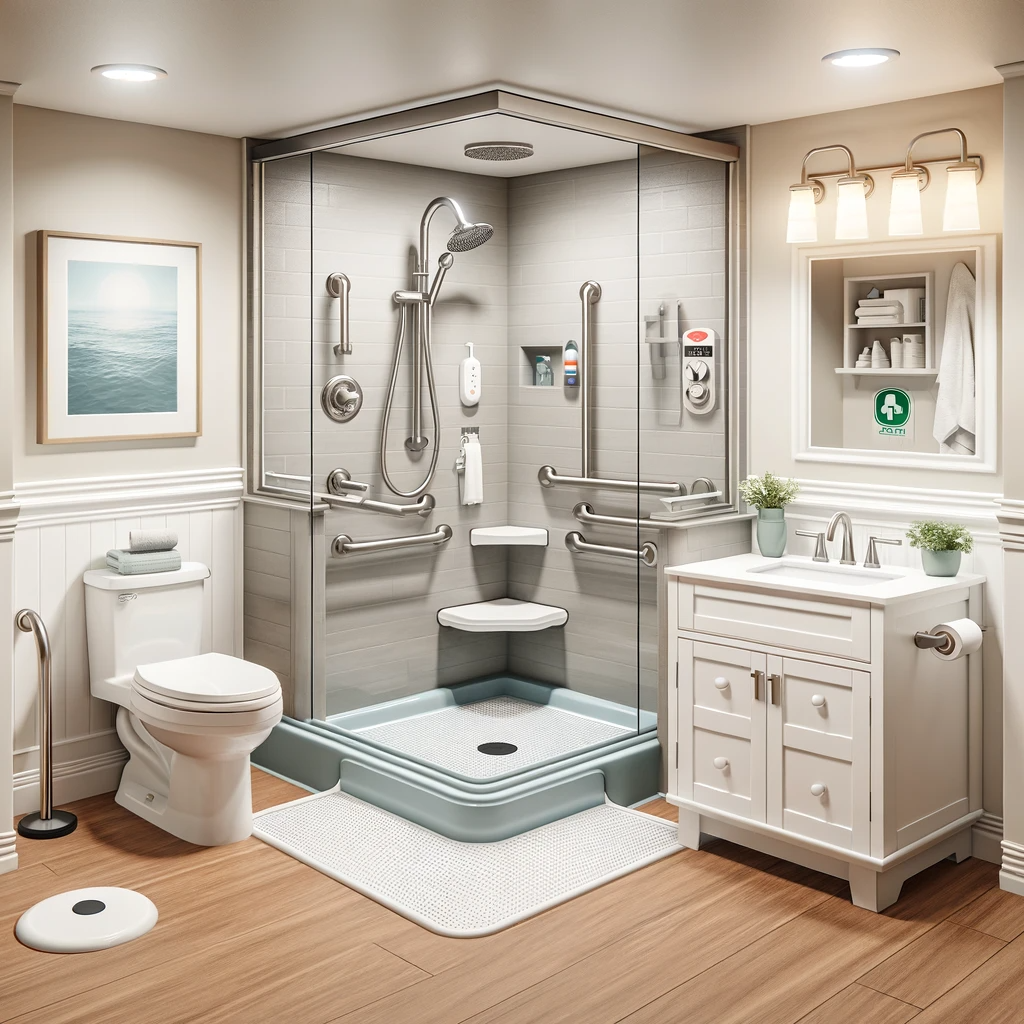
1. Installation of Grab Bars
- Install sturdy grab bars near the toilet, shower, and bathtub areas.
- Ensure they are securely fixed to support the weight of an adult.
2. Use of Raised Toilet Seats
- Provide raised toilet seats with armrests for easier sitting and standing.
- Consider height-adjustable models to suit individual needs.
3. Walk-In Tubs and Showers
- Replace traditional bathtubs with walk-in models to minimize the risk of falls.
- Opt for showers with low or no thresholds for easy access.
4. Non-slip mats and Flooring
- Place non-slip mats inside and outside the shower or tub.
- Use non-slip flooring materials or apply anti-slip coatings to existing floors.
5. Shower Chairs or Benches
- Provide a stable shower chair or bench for seated bathing.
- Choose models with non-slip feet and adjustable height.
6. Handheld Showerheads
- Install handheld showerheads for easier and safer bathing.
- Ensure the hose is long enough for comfortable use from a seated position.
7. Adequate Bathroom Lighting
- Ensure bright, glare-free lighting in all areas of the bathroom.
- Consider night lights for visibility during nighttime bathroom visits.
8. Easy-to-Reach Towel and Toiletry Storage
- Position towel racks and toiletry storage within easy reach from the shower, tub, and toilet.
- Avoid high shelves or cabinets that require reaching or bending.
9. Temperature Control
- Install anti-scald devices on faucets to prevent burns.
- Ensure water heaters are set to a safe temperature.
10. Slip-Resistant Bath Mats
- Use slip-resistant bath mats beside the shower, tub, and sink.
- Choose mats that are securely anchored and do not curl up at the edges.
11. Emergency Call System
- Install an emergency call button or pull cord within reach of the toilet and bath.
- Consider waterproof wearable emergency alert devices.
12. Door Locks and Handles
- Use locks that can be opened from both sides in an emergency.
- Replace knobs with lever handles for easier operation.
13. Safe Personal Care Products
- Organize personal care products for easy access.
- Use non-slip dispensers and avoid glass containers.
Bedroom Safety for Seniors Checklist

1. Suitable Bed Height
- Ensure the bed height allows for easy access – not too high or too low.
- Consider adjustable beds for personalized comfort and support.
2. Bedside Lighting
- Provide ample, easy-to-reach lighting near the bed, such as touch lamps or remote-controlled lights.
- Install night lights for safe navigation at night.
3. Accessible Emergency Communication
- Keep a phone or emergency call device within easy reach of the bed.
- Consider wearable emergency alert devices for added security.
4. Non-Slip Rugs and Flooring
- Place non-slip rugs beside the bed to prevent falls when getting up.
- Ensure the floor surface is even and free of tripping hazards.
5. Easy-to-Use Furniture
- Choose bedside tables with easy-to-open drawers or shelves.
- Avoid furniture with sharp corners or edges.
6. Safe and Accessible Storage
- Keep clothing and other essentials in easily reachable places.
- Use closet organizers to minimize the need for bending or stretching.
7. Adequate Ventilation and Climate Control
- Maintain a comfortable and stable room temperature.
- Ensure good air circulation with fans or air conditioning as needed.
8. Fall-Prevention Strategies
- Keep a flashlight and a sturdy pair of slippers or shoes next to the bed.
- Arrange furniture to create a clear path to the bathroom and door.
9. Medication Management
- Store medications in a safe, easily accessible location.
- Consider using pill organizers to manage daily medication schedules.
10. Supportive Bedding
- Use supportive pillows and mattresses tailored to specific health needs.
- Opt for lightweight and easy-to-handle bedding materials.
11. Personal Alarm Systems
- Install bed alarms or motion sensors for seniors at risk of falls.
- Ensure alarms are connected to caregivers or emergency services if needed.
12. Decorative Comfort
- Personalize the space with comforting and familiar items like photos or keepsakes.
- Choose decorations that are safe and don’t clutter the space.
13. Electrical Safety
- Ensure electrical cords are neatly tucked away and not a tripping hazard.
- Use surge protectors for electrical devices.
Stairways and Hallways Safety for Seniors Checklist

1. Secure and Visible Handrails
- Install sturdy handrails on both sides of stairways, extending beyond the first and last steps.
- Ensure handrails are at an appropriate height and easy to grip.
2. Adequate Lighting
- Provide bright, even lighting along stairways and hallways.
- Consider motion-activated lights or night lights for better visibility at night.
3. Non-Slip Stair Treads
- Apply non-slip treads or strips to each step to prevent slips.
- Keep stair surfaces clean and free of clutter.
4. Step Visibility
- Use contrasting colors or markings on the edge of each step to enhance visibility.
- Consider installing lighted stair treads for additional safety.
5. Stair Lifts or Elevators
- If stairs become too challenging, consider installing a stair lift or a home elevator.
- Ensure professional installation and regular maintenance.
6. Clear and Unobstructed Pathways
- Keep hallways and stairway landings clear of furniture, rugs, and other tripping hazards.
- Regularly check these areas to ensure they remain clutter-free.
7. Slip-Resistant Flooring
- Use slip-resistant flooring materials in hallways.
- Secure any area rugs with non-slip pads or double-sided tape.
8. Emergency Assistance
- Place emergency call buttons or phones in inaccessible locations in hallways and near stairways.
- Ensure seniors know how to call for help if needed.
9. Stairway Width and Space
- Ensure stairways are wide enough to comfortably and safely accommodate the senior and any assistive devices.
- Consider widening narrow staircases if possible.
10. Regular Maintenance
- Inspect and repair any loose carpeting, floorboards, or handrails.
- Keep stairways and hallways well-maintained and in good repair.
11. Seating Options
- Provide a chair or resting place at the top or bottom of stairs for seniors to rest.
- Consider seating in hallways for breaks during movement around the house.
12. Visual Cues
- Use visual cues like colored tape or signs to indicate changes in floor level or other hazards.
- Enhance depth perception with adequate lighting and color contrast.
13. Door Accessibility
- Ensure doors in hallways are easy to open and close, especially for those with mobility issues.
- Replace doorknobs with lever handles for easier operation.
14. Smart Home Technology
- Implement smart home solutions like voice-activated lights or security systems for added safety.
- Use technology to monitor and assist seniors as they move through these areas.
15. Safety Education
- Educate seniors on the importance of holding onto handrails and taking their time on stairs.
- Discuss strategies to safely navigate these areas of the home.
Conclusion: Prioritizing Safety and Accessibility
By taking proactive steps to enhance home safety and accessibility, we can significantly improve the living conditions of seniors. This not only supports their independence but also provides peace of mind for their loved ones. Remember, every small change can make a big difference in ensuring a safe and comfortable environment for the elderly.
Additional Resources and Helpful Links
For more information and guidance, consider exploring the following resources:
This guide serves as a checklist and a resource for ensuring the safety and accessibility of homes for seniors. By focusing on these key areas and continually evaluating and adapting the living environment, we can make a substantial impact on the quality of life for older adults.

